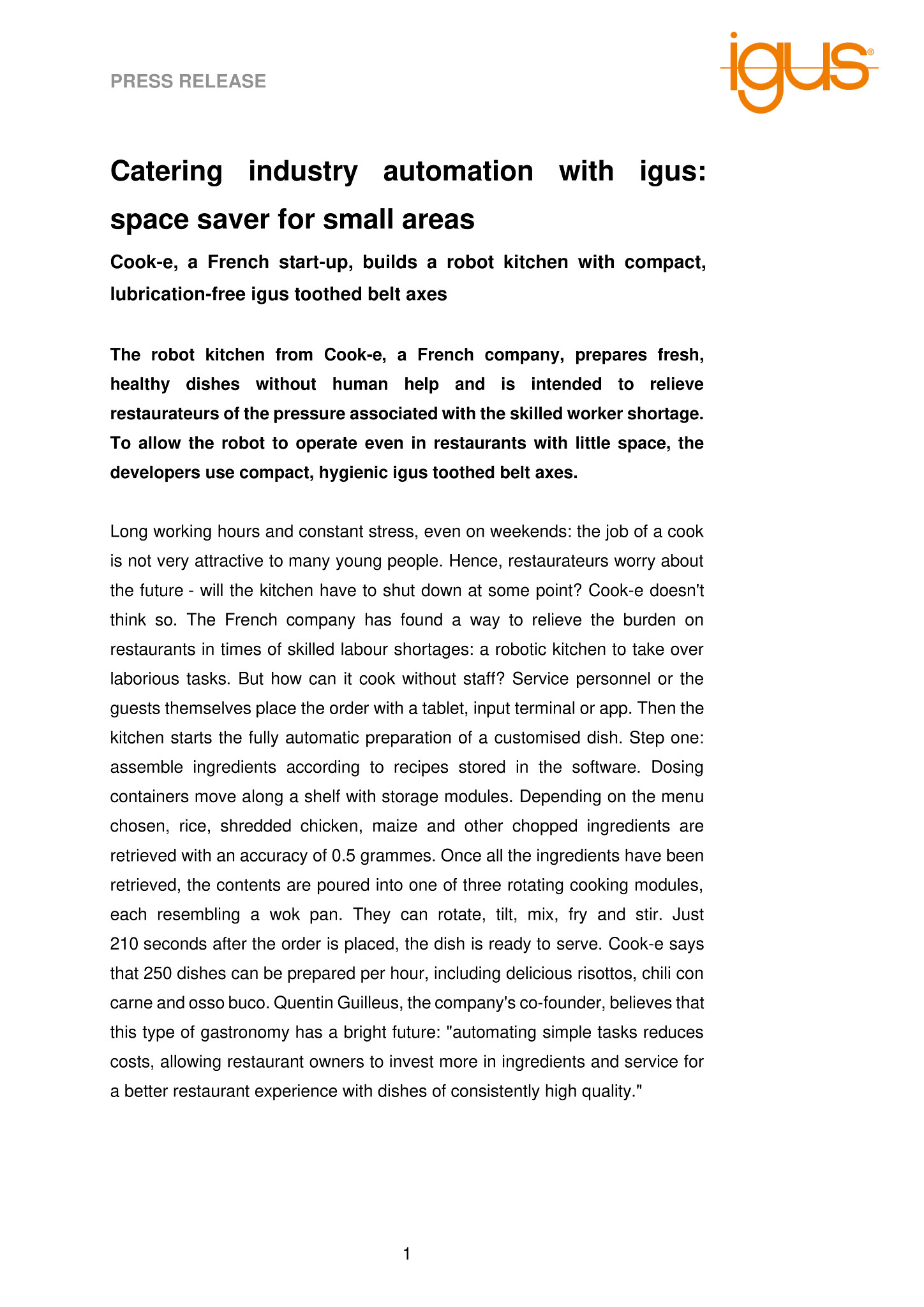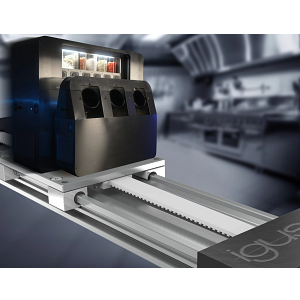Catering industry automation with igus: space saver for small areas
September 29, 2023
Cook-e, a French start-up, builds a robot kitchen with compact, lubrication-free igus toothed belt axes

The robot kitchen from Cook-e, a French company, prepares fresh, healthy dishes without human help and is intended to relieve restaurateurs of the pressure associated with the skilled worker shortage. To allow the robot to operate even in restaurants with little space, the developers use compact, hygienic igus toothed belt axes.
Long working hours and constant stress, even on weekends: the job of a cook is not very attractive to many young people. Hence, restaurateurs worry about the future – will the kitchen have to shut down at some point? Cook-e doesn’t think so. The French company has found a way to relieve the burden on restaurants in times of skilled labour shortages: a robotic kitchen to take over laborious tasks. But how can it cook without staff? Service personnel or the guests themselves place the order with a tablet, input terminal or app. Then the kitchen starts the fully automatic preparation of a customised dish. Step one: assemble ingredients according to recipes stored in the software. Dosing containers move along a shelf with storage modules. Depending on the menu chosen, rice, shredded chicken, maize and other chopped ingredients are retrieved with an accuracy of 0.5 grammes. Once all the ingredients have been retrieved, the contents are poured into one of three rotating cooking modules, each resembling a wok pan. They can rotate, tilt, mix, fry and stir. Just 210 seconds after the order is placed, the dish is ready to serve. Cook-e says that 250 dishes can be prepared per hour, including delicious risottos, chili con carne and osso buco. Quentin Guilleus, the company’s co-founder, believes that this type of gastronomy has a bright future: “automating simple tasks reduces costs, allowing restaurant owners to invest more in ingredients and service for a better restaurant experience with dishes of consistently high quality.”
drylin ZLW: because space in kitchens is worth its weight in gold
To allow as many restaurants as possible to benefit from automation, Cook-e has designed the robotic kitchen to be space-saving. Rental prices are high and kitchens are correspondingly small, especially in major cities. All components are therefore compact, from ingredient storage modules to dosing container positioning mechanics. The engineers initially considered using a linear guide with ball-bearing-supported carriages. That, however, would have taken up too much space, so the experts decided on an alternative: electric igus toothed belt axes. “drylin ZLW-series toothed belt axes are the ideal solution for light adjustment and positioning tasks in limited space where every millimetre counts,” says Michael Hornung, igus Product Manager for drylin Linear and Drive Technology. The clearance height is just 31 millimetres. “The igus solution allows for a more compact design, so our machines’ volume can be reduced,” says Guilleus. The robot kitchen requires just 2.7 square metres of floor space.
Lubrication-free polymer slide bushes ensure hygiene
However, the robotic kitchen’s components have to not only be compact, but also meet the strict hygienic requirements of HACCP, a hygiene concept that NASA originally developed to ensure food safety for astronauts. Says Guilleus, “The materials chosen, mainly stainless steel and PETG, are suitable for contact with food.” The toothed belt axes fit seamlessly here because igus manufactures the trusses and linear carriages from corrosion-resistant stainless steel. The carriages move on linear plain bearings made of high-performance plastic. The key is that the plain bearings require no lubrication and are therefore completely maintenance-free. External greases and lubricants have been eliminated, so all bearing points and surfaces are hygienic, extremely easy to clean and also quick to make ready for use again. This is important because the kitchen automatically cleans itself after every meal prepared, which involves the dosing containers and pan tilting downwards. A high-pressure water jet with cleaning agents performs the actual cleaning.



